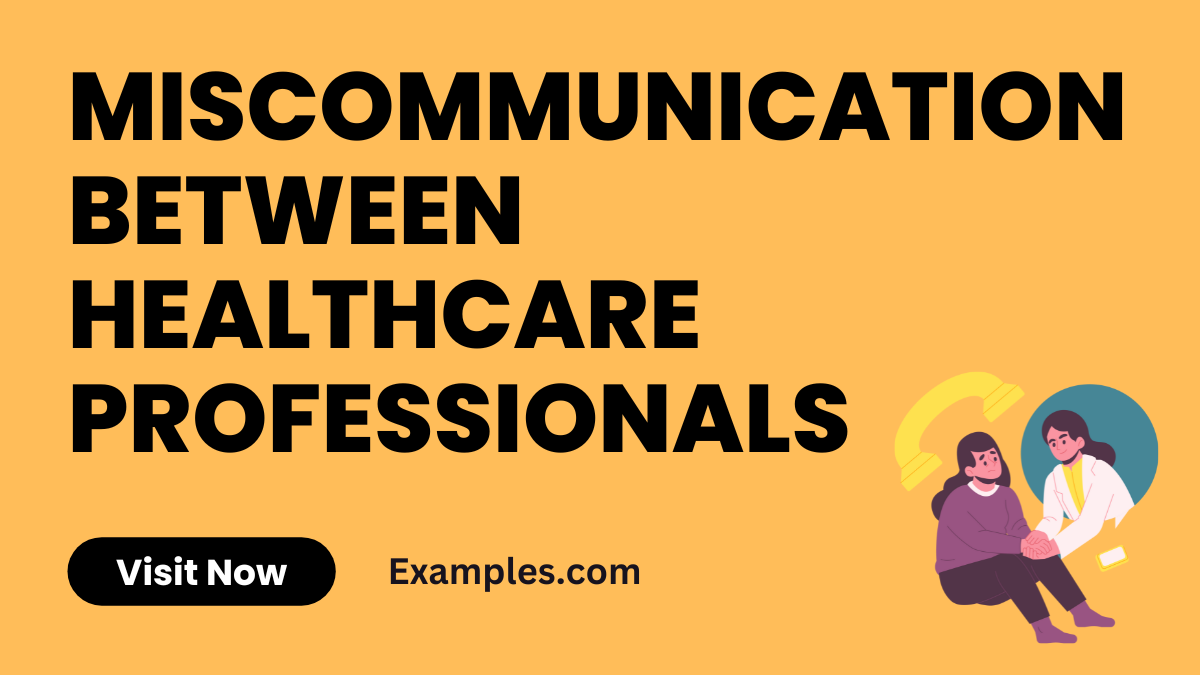19+ Miscommunication Between Healthcare Professionals Examples
Embark on a comprehensive exploration of “Miscommunication Between Healthcare Professionals: A Complete Guide with Communication Examples.” This guide delves into real-life scenarios within medical settings, shedding light on the complexities of communication among healthcare professionals. Uncover valuable insights and practical tips to navigate and enhance collaboration, ensuring clear and effective communication for optimal patient care. Learn from diverse examples that illuminate common pitfalls and dynamics, fostering a culture of effective communication within the healthcare domain.
What is Miscommunication Between Healthcare Professionals?
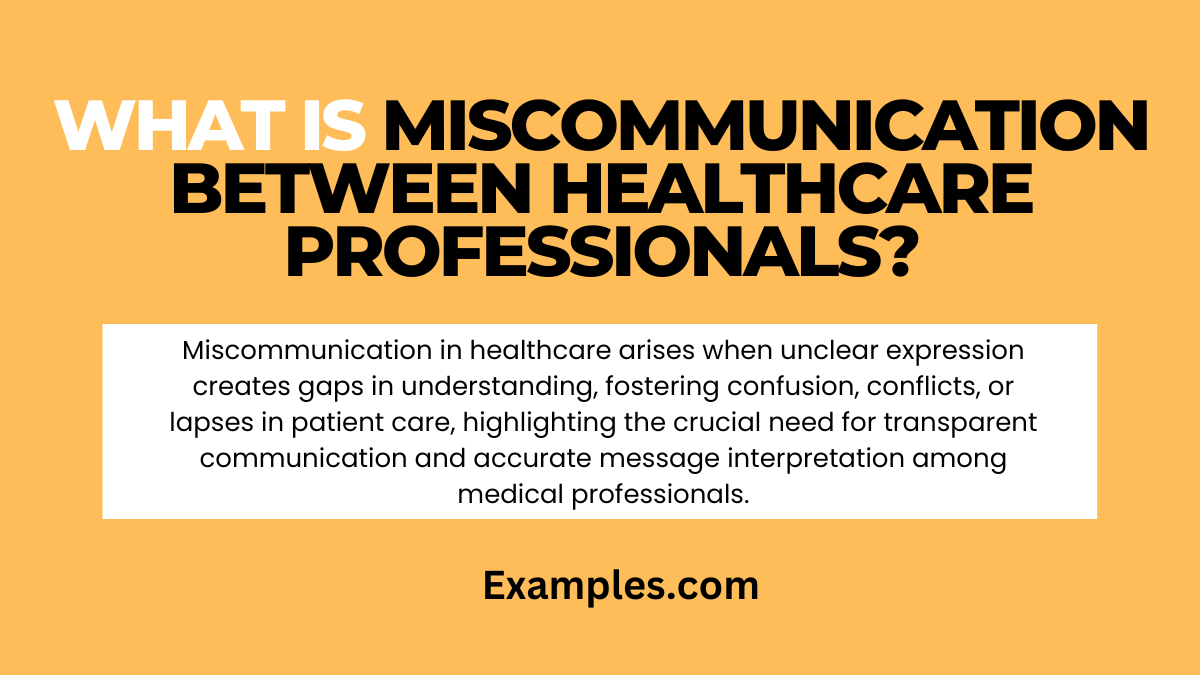
Miscommunication between healthcare professionals occurs when there is a failure to convey thoughts, intentions, or information clearly, leading to misunderstandings. In simple terms, it’s the unintentional gaps in understanding among medical professionals that result in confusion, conflicts, or lapses in patient care. This breakdown in effective communication emphasizes the importance of expressing oneself transparently and interpreting messages accurately within the context of healthcare dynamics.
What is the Best Example of Miscommunication Between Healthcare Professionals?
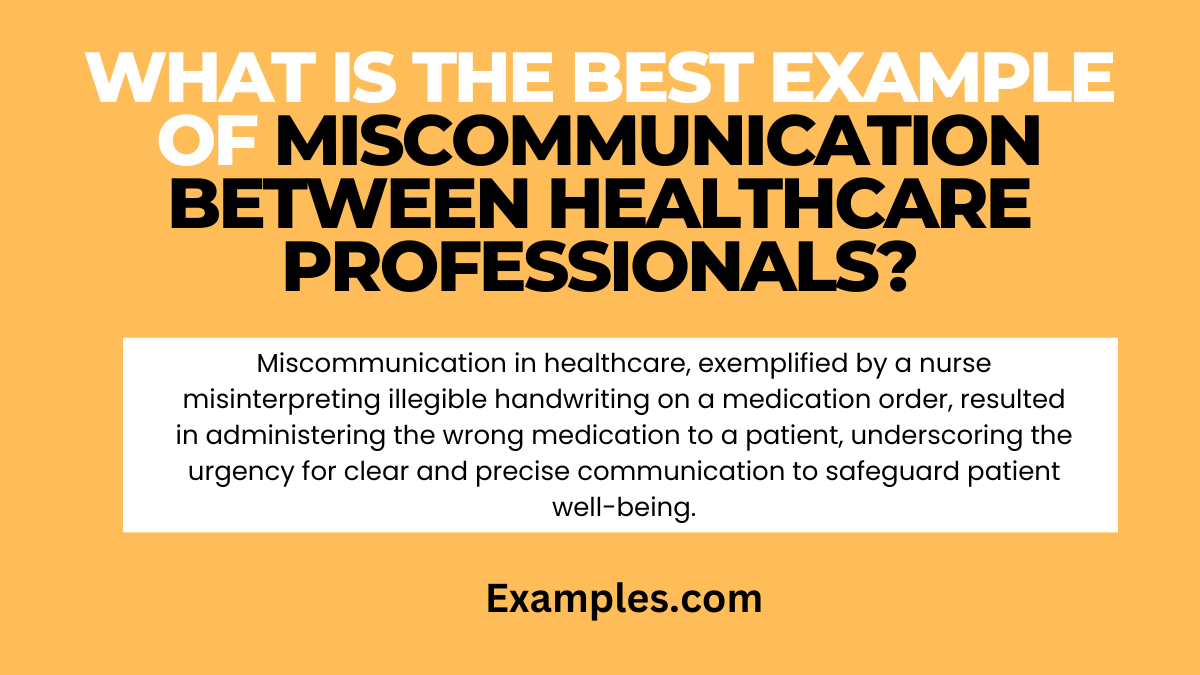
In this scenario, a nurse misinterpreted a medication order due to unclear handwriting from the prescribing doctor. The resulting administration of the wrong medication to the patient led to adverse effects and a delay in the necessary treatment. This detailed example underscores how miscommunication, even in the form of illegible handwriting, can have serious consequences in healthcare settings, highlighting the critical need for clear and precise communication to ensure patient safety.
20 Miscommunication Between Healthcare Professionals Examples
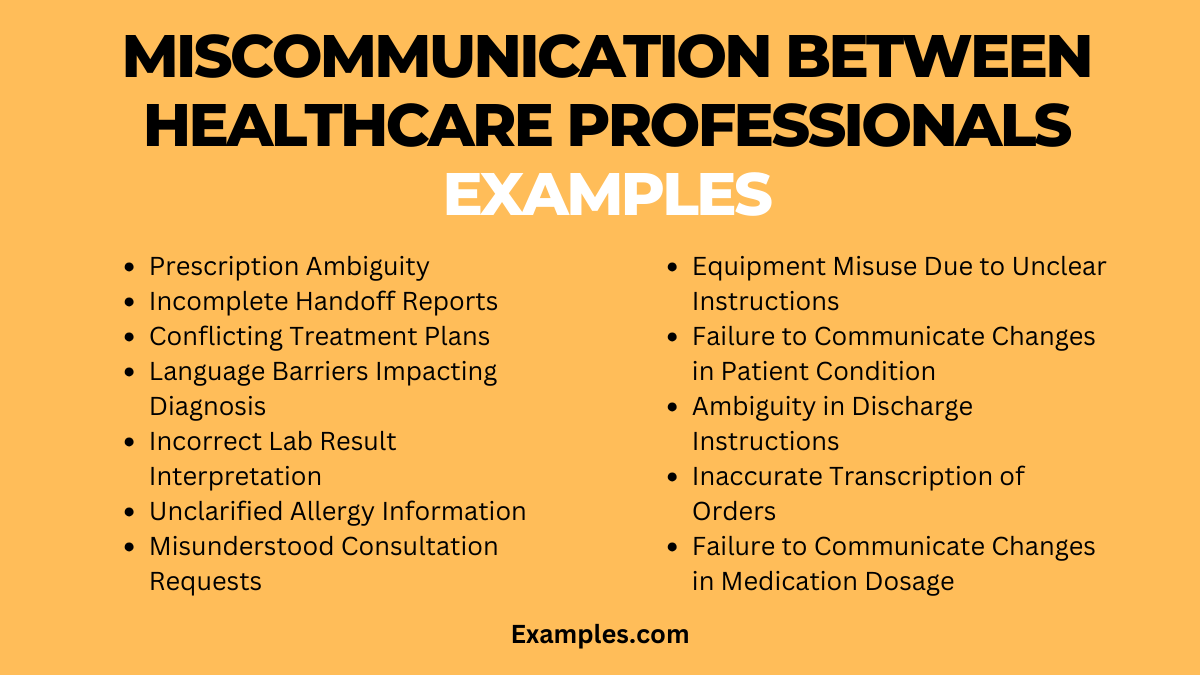
Explore the intricacies of communication within the healthcare realm through these real-life examples. Each scenario highlights potential pitfalls and offers insights into preventing miscommunication among healthcare professionals to ensure optimal patient care.
- Prescription Ambiguity: Miscommunication arises when handwriting on a prescription is unclear; clear and legible prescriptions enhance patient safety.
- Incomplete Handoff Reports: Patient care is compromised when handoff reports lack crucial details; providing comprehensive handoff information ensures continuity of care.
- Conflicting Treatment Plans: Patient well-being is at risk when healthcare professionals have conflicting treatment plans; establishing a unified approach ensures coordinated care.
- Language Barriers Impacting Diagnosis: Miscommunication occurs when language differences hinder accurate diagnosis; utilizing interpreters or language services promotes clear understanding.
- Incorrect Lab Result Interpretation: Patient care is jeopardized when lab results are misinterpreted; fostering effective communication ensures accurate diagnostic decisions.
- Unclarified Allergy Information: Miscommunication arises when allergy details are unclear; thorough and explicit allergy documentation prevents adverse reactions.
- Misunderstood Consultation Requests: Patient care delays occur when consultation requests are misunderstood; providing clear and specific consultation instructions expedites care.
- Equipment Misuse Due to Unclear Instructions: Patient safety is compromised when equipment instructions are unclear; precise and unambiguous guidance prevents misuse.
- Failure to Communicate Changes in Patient Condition: Patient well-being is at risk when changes in condition are not communicated promptly; regular and clear updates ensure timely interventions.
- Ambiguity in Discharge Instructions: Post-discharge complications arise from unclear instructions; providing detailed and understandable discharge instructions enhances patient recovery.
- Documentation Errors Leading to Incorrect Procedures: Patient safety is jeopardized when documentation errors lead to incorrect procedures; meticulous record-keeping prevents such mistakes.
- Miscommunication Regarding Care Preferences: Patient dissatisfaction occurs when healthcare professionals misunderstand care preferences; actively discussing and noting preferences ensures patient satisfaction.
- Unclear Consultation Follow-Up Plans: Patient outcomes are compromised when follow-up plans are unclear; establishing concise and actionable follow-up instructions optimizes care.
- Mismatched Expectations in Team Roles: Conflict arises when team roles are misunderstood; clarifying responsibilities fosters a harmonious healthcare team environment.
- Miscommunication in Emergency Responses: Patient safety is compromised when emergency response plans are unclear; rehearsing and communicating emergency procedures ensures swift and effective responses.
- Inaccurate Transcription of Orders: Patient care is at risk when orders are inaccurately transcribed; implementing clear and standardized order entry systems prevents transcription errors.
- Failure to Communicate Changes in Medication Dosage: Patient health is compromised when changes in medication dosage are not communicated; ensuring transparent communication prevents dosage errors.
- Unclear Communication in Surgical Procedures: Complications arise when surgical procedures are not communicated clearly; thorough pre-operative discussions ensure procedural understanding.
- Misunderstood End-of-Life Care Wishes: Patient and family distress occurs when end-of-life wishes are misunderstood; engaging in open and empathetic discussions ensures respectful care.
- Unclarified Patient History Details: Patient care is compromised when healthcare professionals misinterpret historical details; ensuring comprehensive and accurate patient histories prevents mismanagement.
Explore these examples to gain insights into the challenges of communication in healthcare and learn how to prevent miscommunication for the well-being of both healthcare professionals and their patients.
Miscommunication Between Healthcare Professionals for Patients Examples
Explore instances where miscommunication among healthcare professionals impacts patient care. Gain insights into the challenges and solutions, ensuring a collaborative and patient-centric healthcare environment.
- Delayed Test Results Disclosure: Miscommunication occurs when test results are not promptly communicated; implementing streamlined communication channels ensures timely patient updates.
- Conflicting Medication Advice: Patient safety is compromised when healthcare professionals provide conflicting medication advice; fostering open dialogue and unified recommendations enhances patient well-being.
- Uncoordinated Post-Discharge Plans: Patient care suffers when post-discharge plans are uncoordinated; establishing clear communication among professionals ensures seamless transitions for patients.
- Communication Gaps in Palliative Care: Miscommunication arises in palliative care discussions; actively addressing patient and family concerns through transparent communication improves end-of-life experiences.
- Unclear Rehabilitation Protocols: Patient recovery is hindered when rehabilitation protocols are unclear; providing explicit instructions and involving the patient in the process ensures effective rehabilitation.
Miscommunication Between Healthcare Professionals in Nursing Examples
Explore instances where miscommunication among nursing professionals impacts patient care. Discover solutions to enhance communication within the nursing team and improve overall patient outcomes.
- Incomplete Patient Handoffs: Patient safety is at risk when handoff reports lack essential details; implementing comprehensive handoff protocols ensures continuity of nursing care.
- Unclear Medication Administration Instructions: Miscommunication occurs when medication administration instructions are unclear; utilizing standardized protocols and double-checks prevents medication errors.
- Misunderstood Patient Preferences: Patient satisfaction is compromised when nursing professionals misunderstand patient preferences; actively engaging in discussions and documenting preferences ensures personalized care.
- Communication Gaps in Wound Care: Patient healing is hindered when communication gaps exist in wound care instructions; ensuring clear and detailed communication among nursing staff promotes effective wound management.
- Uncertain Implementation of Nursing Protocols: Patient outcomes are compromised when nursing protocols are implemented with uncertainty; clarifying procedures and providing ongoing training ensures adherence to best practices.
By exploring these examples, healthcare professionals can understand the nuances of miscommunication in patient care and nursing practices, fostering a culture of clear communication and collaboration for the benefit of patients and healthcare teams alike.
What are the potential problems for miscommunication in healthcare?
Miscommunication in healthcare can lead to critical issues impacting patient safety and well-being. Delve into the potential problems associated with miscommunication among healthcare professionals to better understand the challenges and foster a culture of effective communication.
1. Incomplete Patient Handoffs: Incomplete handoff reports during shift changes can result in crucial patient information being overlooked, leading to compromised care and potential medical errors.
2. Ambiguous Medication Instructions: Unclear medication instructions can jeopardize patient safety, causing healthcare professionals to administer incorrect doses or medications.
3. Discrepancies in Treatment Plans: Conflicting treatment plans among healthcare teams can result in fragmented care, hindering the patient’s overall recovery process.
4. Communication Gaps in Critical Situations: In emergency situations, communication gaps may delay crucial interventions, impacting patient outcomes and increasing the risk of adverse events.
5. Misinterpretation of Diagnostic Results: Miscommunication in conveying diagnostic results can lead to incorrect interpretations, affecting treatment decisions and potentially causing harm to patients.
6. Unclear Post-Operative Care Instructions: Inadequate communication regarding post-operative care instructions may result in patients not following essential recovery measures, leading to complications.
7. Language Barriers Impacting Consultations: Language differences among healthcare professionals may hinder effective consultations, impeding the accurate exchange of critical information about patient conditions and treatment plans.
8. Lack of Interdisciplinary Collaboration: Failure to foster interdisciplinary collaboration can result in a fragmented approach to patient care, missing holistic perspectives and potentially causing oversight in treatment.
What are the effects of miscommunication between healthcare professionals?
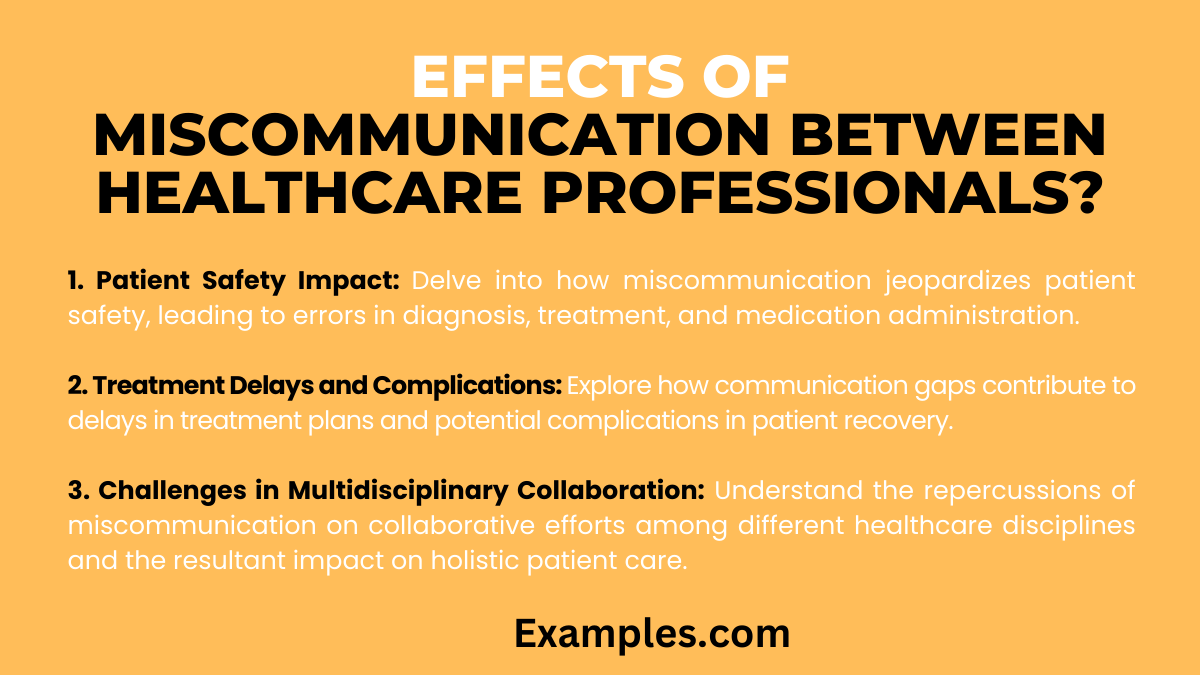
Miscommunication within the healthcare domain can have profound consequences on patient care, team dynamics, and overall organizational efficiency. This guide explores in-depth the multifaceted effects of miscommunication between healthcare professionals, shedding light on the following key aspects:
- Patient Safety Impact: Delve into how miscommunication jeopardizes patient safety, leading to errors in diagnosis, treatment, and medication administration.
- Treatment Delays and Complications: Explore how communication gaps contribute to delays in treatment plans and potential complications in patient recovery.
- Challenges in Multidisciplinary Collaboration: Understand the repercussions of miscommunication on collaborative efforts among different healthcare disciplines and the resultant impact on holistic patient care.
- Strain on Interprofessional Relationships: Examine how miscommunication strains relationships among healthcare professionals, affecting teamwork, morale, and job satisfaction.
- Financial Implications for Healthcare Organizations: Uncover the financial repercussions of miscommunication, including increased costs related to medical errors, malpractice claims, and inefficiencies.
- Legal and Ethical Consequences: Investigate the legal and ethical implications of miscommunication, addressing potential lawsuits, breaches of patient confidentiality, and ethical dilemmas.
- Patient Satisfaction and Trust Erosion: Explore the correlation between miscommunication, patient dissatisfaction, and the erosion of trust in healthcare professionals and institutions.
- Impact on Staff Burnout and Well-being: Understand how miscommunication contributes to staff burnout, stress, and diminished overall well-being among healthcare professionals.
This comprehensive guide aims to equip healthcare professionals, administrators, and stakeholders with a profound understanding of the far-reaching consequences of miscommunication within the healthcare sector. By addressing these effects head-on, healthcare organizations can work towards creating an environment that prioritizes clear communication, collaboration, and ultimately, improved patient outcomes.
In conclusion, miscommunication among healthcare professionals poses significant risks, impacting patient safety, team dynamics, and organizational efficiency. This comprehensive guide underscores the diverse effects, from treatment delays to legal consequences. By recognizing and addressing these challenges, healthcare professionals can work towards fostering a communication-rich environment, ultimately enhancing patient care and overall healthcare outcomes.



